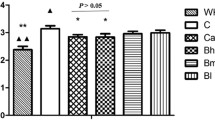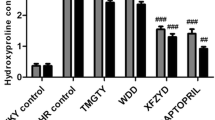Abstract
Objective
To study effects of Shenmai Injection on hypertensive heart failure and its mechanism for inhibiting myocardial fibrosis.
Methods
Salt-sensitive (Dahl/SS) rats were fed with normal diet (0.3% NaCl) and the high-salt diet (8% NaCl) to observe the changes in blood pressure and heart function, as the control group and the model group. Salt-insensitive rats (SS-13BN) were fed with the high-salt diet (8% NaCl) as the negative control group. After modeling, the model rats were randomly divided into heart failure (HF) group, Shenmai Injection (SMI) group and pirfenidone (PFD) group by a random number table, with 6 rats in each group. They were given sterilized water, SMI and pirfenidone, respectively. Blood pressure, cardiac function, fibrosis and related molecular expression were detected by sphygmomanometer, echocardiogram, enzyme linked immunosorbent assay (ELISA), hematoxylin-eosin staining, Masson staining, immunofluorescence and qPCR analysis.
Results
After high-salt feeding, compared with the control and negative control group, in the model group the blood pressure increased significantly, the left ventricular ejection fraction (LVEF) and left ventricular fraction shortening (LVFS) were significantly reduced, and the serum NT-proBNP concentration increased significantly (all P<0.05); furthermore, the arrangement of myocardial cells was disordered, the edema was severe, and the degree of myocardial fibrosis was also significantly increased (P<0.05); the protein and mRNA expressions of collagen type I (Col I) were up-regulated (P<0.05), and the mRNA expressions of transforming growth factor β 1 (TGF- β 1), Smad2 and Smad3 were significantly up-regulated (P<0.05). Compared with HF group, after intervention of Shenmai Injection, LVEF and LVFS increased, myocardial morphology was improved, collagen volume fraction decreased significantly (P<0.05), and the mRNA expressions of Col I, TGF- β 1, Smad2 and Smad3, as well as Col I protein expression, were all significantly down-regulated (all P<0.05).
Conclusion
Myocardial fibrosis is the main pathological manifestation of hypertensive heart failure, and Shenmai Injection could inhibit myocardial fibrosis and effectively improve heart failure by regulating TGF-β 1/Smad signaling pathway.
Similar content being viewed by others
Availability of Data and Materials
The data and materials used to support the findings of this study are available from the corresponding author upon request.
References
World Health Organization: About cardiovascular diseases. https://www.who.int/cardiovascular_diseases/about_cvd/en/(2019). Accessed.
Tanai E, Frantz S. Pathophysiology of heart failure. Compr Physiol 2015;6:187–214.
Zhou Y, Zhong SJ, Hu SY, Dong WB, Yao T, Liang H, et al. Comparison of the effects of Shenfu Injection and Shenmai Injection on doxorubicin-induced chronic heart failure in rats. Int J Clin Exp Med 2018;11:13169–13179.
Li YM, Wang LL, Dong ZH, Wang SY, Qi LL, Cho K, et al. Cardioprotection of salvianolic acid B and ginsenoside Rg1 combination on subacute myocardial infarction and the underlying mechanism. Phytomedicine 2019;57:255–261.
Zheng X, Wang S, Zou XM, Jing YT, Yang RL, Li SQ, et al. Ginsenoside Rb1 improves cardiac function and remodeling in heart failure. Exp Anim 2017;66:217–228.
Liu XM, Jiang YC, Fu WW, Yu XF, Sui DY. Combination of the ginsenosides Rb3 and Rb2 exerts protective effects against myocardial ischemia reperfusion injury in rats. Int J Mol Med 2020;45:519–531.
Zhang K, Zhang JY, Wang XR, Wang L, Pugliese M, Passantino A, et al. Cardioprotection of Sheng Mai Yin a classic formula on adriamycin induced myocardial injury in Wistar rats. Phytomedicine 2018;38:1–11.
World Medical Association, American Physiological Society. Guiding principles for research involving animals and human beings. Am J Physiol Regul Integr Comp Physiol 2002;283:R281–283.
Boluyt MO, Bing OH, Lakatta EG. The ageing spontaneously hypertensive rat as a model of the transition from stable compensated hypertrophy to heart failure. Eur Heart J 1995;16 Suppl N:19–30.
Houser SR, Margulies KB, Murphy AM, Spinale FG, Francis GS, Prabhu SD, et al. Animal models of heart failure: a scientific statement from the American Heart Association. Circ Res 2012;111:131–150.
Klotz S, Hay I, Zhang GP, Maurer M, Wang J, Burkhoff D. Development of heart failure in chronic hypertensive Dahl rats: focus on heart failure with preserved ejection fraction. Hypertension 2006;47:901–911.
Yamamoto M, Ishizu T, Seo Y, Suto Y, Sai S, Xu DZ, et al. Teneligliptin prevents cardiomyocyte hypertrophy, fibrosis, and development of hypertensive heart failure in Dahl saltsensitive rats. J Card Fail 2018;24:53–60.
Pfeffer MA. Heart failure and hypertension: importance of prevention. Med Clin North Am 2017;101:19–28.
Kannan A, Janardhanan R. Hypertension as a risk factor for heart failure. Curr Hypertens Rep 2014;16:447.
Messerli FH, Rimoldi SF, Bangalore S. The transition from hypertension to heart failure: contemporary update. JACC Heart Fail 2017;5:543–551.
The Criteria Committee of the New York Heart Association. Nomenclature and criteria for diagnosis of diseases of the heart and great vessels. Little Brown, Boston, Mass, USA; 1994.
Jessup M, Brozena S. Heart failure. N Engl J Med 2003;348:2007–18.
Januzzi JL, Jr., Camargo CA, Anwaruddin S, Baggish AL, Chen AA, Krauser DG, et al. The N-terminal pro-BNP investigation of dyspnea in the emergency department (PRIDE) study. Am J Cardiol 2005;95:948–954.
Chinese Medical Association, Chinese Medical Journals Publishing House, Chinese Society of General Practice, Editorial Board of Chinese Journal of General Practitioners of Chinese Medical Association, Expert Group of Guidelines for Primary Care of Cardiovascular Disease. Guideline for primary care of acute heart failure. Chin J Gen Pract 2019;18:925–930.
Li J, Zhang YH, Wang F, Liu B, Li H, Tang GD, et al. Cardiac damage in patients with the severe type of coronavirus disease 2019 (COVID-19). BMC Cardiovasc Disord 2020;20:479.
Moncrieff J, Lindsay MM, Dunn FG. Hypertensive heart disease and fibrosis. Curr Opin Cardiol 2004;19:326–331.
Xie J, Tu T, Zhou SH, Liu QM. Transforming growth factor (TGF)-β 1 signal pathway: A promising therapeutic target for attenuating cardiac fibrosis. Int J Cardiol 2017;239:9.
Kamato D, Burch ML, Piva TJ, Rezaei HB, Rostam MA, Xu SW, et al. Transforming growth factor-β signalling: role and consequences of Smad linker region phosphorylation. Cell Signal 2013;25:2017–2024.
Goumans MJ, Ten Dijke P. TGF-β signaling in control of cardiovascular function. Cold Spring Harb Perspect Biol 2018;10:a022210.
Shi LW, Xie YM, Liao X, Chai Y, Luo YH. Shenmai Injection as an adjuvant treatment for chronic cor pulmonale heart failure: a systematic review and meta-analysis of randomized controlled trials. BMC Complement Altern Med 2015;15:418.
Lu LY, Zheng GQ, Wang Y. An overview of systematic reviews of shenmai injection for healthcare. Evid Based Complement Alternat Med 2014;2014:840650.
Karmazyn M, Gan XT. Treatment of the cardiac hypertrophic response and heart failure with ginseng, ginsenosides, and ginseng-related products. Can J Physiol Pharmacol 2017;95:1170–1176.
Ma J, Ma SY, Yin CX, Wu HL. Shengmai San-derived herbal prevents the development of a vulnerable substrate for atrial fibrillation in a rat model of ischemic heart failure. Biomed Pharmacother 2018;100:156–167.
Dobaczewski M, Chen W, Frangogiannis NG. Transforming growth factor (TGF)-β signaling in cardiac remodeling. J Mol Cell Cardiol 2011;51:600–606.
Cicero AFG, Colletti A. Nutraceuticals and dietary supplements to improve quality of life and outcomes in heart failure patients. Curr Pharm Des 2017;23:1265–1272.
Schichtel M, Wee B, Perera R, Onakpoya I. The effect of advance care planning on heart failure: a systematic review and meta-analysis. J Gen Intern Med 2020;35:874–884.
Graziani F, Varone F, Crea F, Richeldi L. Treating heart failure with preserved ejection fraction: learning from pulmonary fibrosis. Eur J Heart Fail 2018;20:1385–1391.
Kasahara K, Rey FE. The emerging role of gut microbial metabolism on cardiovascular disease. Curr Opin Microbiol 2019;50:64–70.
Burlacu A, Siriopol D, Voroneanu L, Nistor I, Hogas S, Nicolae A, et al. Atherosclerotic renal artery stenosis prevalence and correlations in acute myocardial infarction patients undergoing primary percutaneous coronary interventions: data from nonrandomized single-center study (REN-ACS)—a single center, prospective, observational study. J Am Heart Assoc 2015;4:e002379.
Guan H, Dai GH, Gao WL, Zhang T, Sun C, Ren LL, et al. Effect of Shenmai Injection on long-term prognosis of patients with chronic heart failure: a multicenter, large sample capacity, long-term follow-up retrospective cohort study. Chin J Integr Med 2022;28:312–318.
Wang SM, Ye LF, Wang LH. Shenmai Injection improves energy metabolism in patients with heart failure: a randomized controlled trial. Front Pharmacol 2020;11:459.
Yu JH, Li YH, Liu XY, Ma Z, Michael S, Orgah JO, et al. Mitochondrial dynamics modulation as a critical contribution for Shenmai injection in attenuating hypoxia/reoxygenation injury. J Ethnopharmacol 2019;237:9–19.
Author information
Authors and Affiliations
Contributions
Hu SY conceived the study and wrote most parts of the manuscript. Zhou Y completed most of the experiments and testing work. Hu ZX provided methodological support in the study design and revised the manuscript. Zhong SJ, Yang M, Huang SM, Li L and Li XC searched and analyzed some literature. All authors have read and approved the manuscript before submission. All authors reviewed the manuscript.
Corresponding author
Additional information
Conflict of Interest
All authors declare that there is no conflict of interests.
Consent for Publication
All authors confirm that the work described has not been published before, that its publication has been approved by all co-authors.
Supported by Hunan Provincial Natural Science Foundation of China (No. 2020JJ5408), Scientific Research Fund of Hunan Provincial Education Department (No. 21B0361), Research Fund of Hunan University of Chinese Medicine (No. 2019XJJJ012), and Zhuzhou Second Batch of Science and Technology Guidance Projects (No. 2017-17)
Rights and permissions
About this article
Cite this article
Hu, Sy., Zhou, Y., Zhong, Sj. et al. Shenmai Injection Improves Hypertensive Heart Failure by Inhibiting Myocardial Fibrosis via TGF-β 1/Smad Pathway Regulation. Chin. J. Integr. Med. 29, 119–126 (2023). https://doi.org/10.1007/s11655-022-2899-y
Accepted:
Published:
Issue Date:
DOI: https://doi.org/10.1007/s11655-022-2899-y




